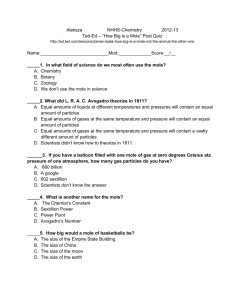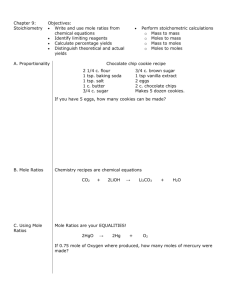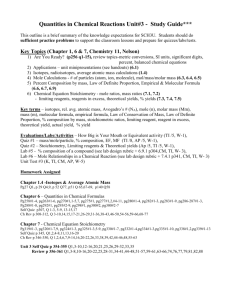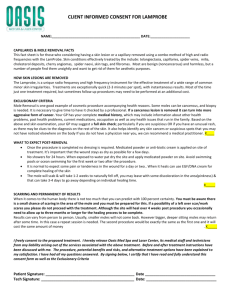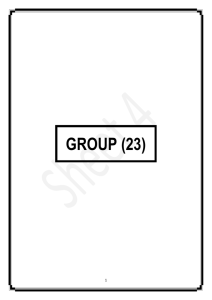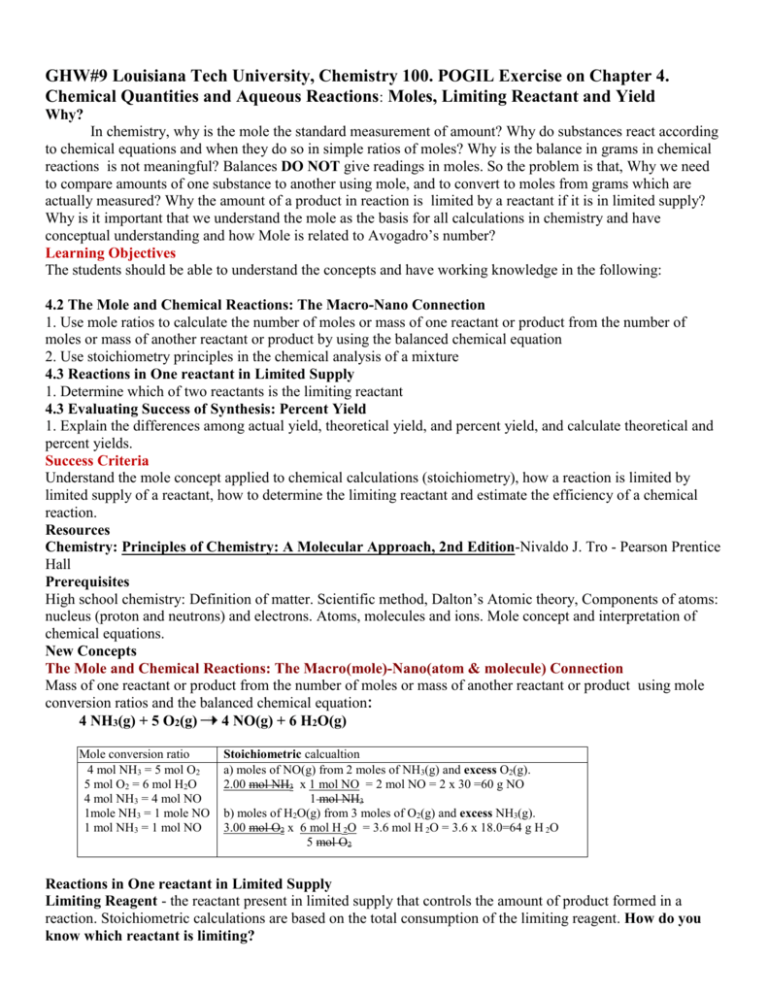
GHW#9 Louisiana Tech University, Chemistry 100. POGIL Exercise on Chapter 4.
Chemical Quantities and Aqueous Reactions: Moles, Limiting Reactant and Yield
Why?
In chemistry, why is the mole the standard measurement of amount? Why do substances react according
to chemical equations and when they do so in simple ratios of moles? Why is the balance in grams in chemical
reactions is not meaningful? Balances DO NOT give readings in moles. So the problem is that, Why we need
to compare amounts of one substance to another using mole, and to convert to moles from grams which are
actually measured? Why the amount of a product in reaction is limited by a reactant if it is in limited supply?
Why is it important that we understand the mole as the basis for all calculations in chemistry and have
conceptual understanding and how Mole is related to Avogadro’s number?
Learning Objectives
The students should be able to understand the concepts and have working knowledge in the following:
4.2 The Mole and Chemical Reactions: The Macro-Nano Connection
1. Use mole ratios to calculate the number of moles or mass of one reactant or product from the number of
moles or mass of another reactant or product by using the balanced chemical equation
2. Use stoichiometry principles in the chemical analysis of a mixture
4.3 Reactions in One reactant in Limited Supply
1. Determine which of two reactants is the limiting reactant
4.3 Evaluating Success of Synthesis: Percent Yield
1. Explain the differences among actual yield, theoretical yield, and percent yield, and calculate theoretical and
percent yields.
Success Criteria
Understand the mole concept applied to chemical calculations (stoichiometry), how a reaction is limited by
limited supply of a reactant, how to determine the limiting reactant and estimate the efficiency of a chemical
reaction.
Resources
Chemistry: Principles of Chemistry: A Molecular Approach, 2nd Edition-Nivaldo J. Tro - Pearson Prentice
Hall
Prerequisites
High school chemistry: Definition of matter. Scientific method, Dalton’s Atomic theory, Components of atoms:
nucleus (proton and neutrons) and electrons. Atoms, molecules and ions. Mole concept and interpretation of
chemical equations.
New Concepts
The Mole and Chemical Reactions: The Macro(mole)-Nano(atom & molecule) Connection
Mass of one reactant or product from the number of moles or mass of another reactant or product using mole
conversion ratios and the balanced chemical equation:
4 NH3(g) + 5 O2(g)
4 NO(g) + 6 H2O(g)
Mole conversion ratio
4 mol NH3 = 5 mol O2
5 mol O2 = 6 mol H2O
4 mol NH3 = 4 mol NO
1mole NH3 = 1 mole NO
1 mol NH3 = 1 mol NO
Stoichiometric calcualtion
a) moles of NO(g) from 2 moles of NH3(g) and excess O2(g).
2.00 mol NH3 x 1 mol NO = 2 mol NO = 2 x 30 =60 g NO
1 mol NH3
b) moles of H2O(g) from 3 moles of O2(g) and excess NH3(g).
3.00 mol O2 x 6 mol H 2O = 3.6 mol H 2O = 3.6 x 18.0=64 g H 2O
5 mol O2
Reactions in One reactant in Limited Supply
Limiting Reagent - the reactant present in limited supply that controls the amount of product formed in a
reaction. Stoichiometric calculations are based on the total consumption of the limiting reagent. How do you
know which reactant is limiting?
aA+bB
cC
1. Comparing stoichiometric ratio to actual mole ratio of reactants
Actual ratio < a / b => A is limiting; > a / b => bA; = a / b => stoichiometric
E.g Determine if the reaction is stoichiometric, or one reagent is in excess/one reagent is limiting for the
reaction: 2H2(g) + 1O2(g) = 2 H2O(l),
a) If 2 mole H2 and 1.00 mole of O2 are reacted according to the equation:
Stoichiometric ratio (mole H2/ mole of O2)= 2/1 = 2
Actual mole ratio (mole H2/ mole of O2)= 2/1=2
Stoichiometric ratio= Actual mole ratio, reaction is stoichiometric
b) If 1 mole H2 and 1.00 mole of O2 are reacted according to the equation:
Stoichiometric ratio (mole H2/ mole of O2)= 2/1 = 2
Actual mole ratio (mole H2/ mole of O2)= 1/1=1
Stoichiometric ratio> Actual mole ratio, reaction is H2 limiting
2. Calculating the amount of A needed to react with a given quantity of B
Comparing the calculated amount of Ac needed to react with the amount of B with actual amount of Aa given:
Ac< Aa then B is limiting; Ac > Aa then B is limiting; Ac= Aa stoichiometric reaction
a) If 2 mole H2 and 1.00 mole of O2 are reacted according to the equation:
Calculated amount of O2 need to react with 2 mole H2 and 1.00:
Ac(O2) = 2 mole H2 x 1 mole of O2 = 1 mole of O2
2 mole of H2
Aa(O2) = 1 mole of O2
Ac= Aa stoichiometric reaction
b) If 1 mole H2 and 1.00 mole of O2 are reacted according to the equation:
Ac(O2) = 1 mole H2 x 1 mole of O2 = 0.5 mole of O2
2 mole of H2
Aa(O2) = 1.0 mole of O2
Ac(O2) < Aa(O2) then H2 is limiting
3. Calculate the theoretical yield based on the amount present of each reactant
limiting reagent = reactant that predicts the smaller theoretical yield
Evaluating Success of Synthesis: Comparing Theoretical Yield and Actual Yield
Theoretical Yield - the quantity of product that is theoretically obtainable from a chemical reaction given the
stoichiometric factor relating product and limiting reagent
Actual Yield - the quantity of product experimentally obtained from a chemical reaction
Percent Yield - the ratio of actual yield to
theoretical
yield, multiplied by 100; used as an index of
efficiency of a
chemical reaction
GHW#9 Name:________________________ Date submitted:_________Group:_______
Key Questions (relatively simple to answer using the Focus Information)
The Mole and Chemical Reactions: The Macro(mole)-Nano(atom & molecule) Connection
1. Given the balanced reactions: 2H2(g) + O2(g) = 2 H2O(l),Write the mole conversion factors:
2. My recipe ratio for a bacon double cheeseburger is:
hamburger bun hamburger patties
slices of cheese
1
2
1
strips of bacon
2
1 bun + 2 hamburger patties + 1 slices of cheese + 2 strips of bacon = 1 bacon double cheeseburger
if you start with: 2 bun, 6 patties, 4 slices of cheese, 6 strips of bacon
a) How many bacon double cheeseburgers can you make?
b) Which ingredient is limiting?
c) What ingredients would be left over or in excess?
3. Determine if the reaction is stoichiometric, or one reagent is in excess/one reagent is limiting for the
reaction: 3H2(g) + 1N2(g) = 2 NH3(g)
a) If 3 mole H2 and 1.00 mole of N2 are reacted according to the equation:
Stoichiometric ratio (mole H2/ mole of N2)=
Actual mole ratio (mole H2/ mole of N2)=
b) Is stoichiometric ratio equal, grate or less than actual mole ratio?
c) Is the reaction stoichiometric, H2 limiting or N2 limiting?
4. Determine if the reaction is stoichiometric, or one reagent is in excess/one reagent is limiting for the
reaction: 2H2(g) + 1O2(g) = 2 H2O (l)
a) If 1 mole H2 and 2.00 mole of O2 are reacted according to the equation:
Stoichiometric ratio (mole H2/ mole of O 2)=
Actual mole ratio (mole H2/ mole of O 2)=
b) Is stoichiometric equal, grate or less than actual mole ratio?
c) Is the reaction stochiometric, H2 limiting or O 2 limiting?
5. 2 Al (s) + Fe2O3 (s) = 2 Fe(l) + Al2O3
takes place in the thermite mixture when it is ignited by a magnesium ribbon. A thermite mixture contains
a mass ratio of 1 to 2 for Al and Fe2O3. Which one is the limiting reagent?
6. Consider the reaction: 2H2(g) + O2(g) = 2 H2O(l)
a) Equal weights of H2 and O2 are placed in a balloon and then ignited. Assume reaction goes to
completion, which gas is the excess reagent?
b) How many moles of H2O will be produced by 0.80 mole of O2 and excess H2, according to the
equation?
b) How many moles of H2O will be produced by 25.6g of O2 and excess H2, according to the equation?
c) How many grams moles of H2O will be produced by 25.6g of O2 and excess H2, according to the
equation?
7. Two moles of Mg and five moles of O2 are placed in a reaction vessel, and then the Mg is ignited to
produce MgO(F.W.=40.31 g/mole)
a) The balanced chemical reaction:
b) The limiting reactant?
Actual mole ratio:
Calculated mole ratio:
c) How many moles of MgO are formed?
d) What is the weight of MgO formed?
8. Write the balanced chemical equation for the reaction where zinc is producing silver in a single
displacement reaction with silver chloride.
9. If 15.00 g of Zn (A.M.= 65.39 g/mole) reacts with silver with 25.00 g AgCl
(F.M.= 143.35 g/mole)?
a) Actual moles of Zn= 0.229
b) Actual moles of AgCl= 0.174
c) Stoichiometric ratio (mole Zn/ mole of AgCl)= ½ = 0.5
d) Actual mole ratio (mole Zn/ mole of AgCl)= 1.32
e) What is limiting reactant?
b) Mole of Ag produced?
c) Grams of Ag produced (theoretical yield)?
d) If the actual yield of Ag was found to be 16.1 g Ag, the percent yield =
10. When 10.0 g pure solid calcium carbonate, CaCO3 is heated and converted to solid calcium oxide CaO
and CO2 gas:
a) The balanced chemical reaction:
b) How much calcium oxide should be theoretically obtained?




